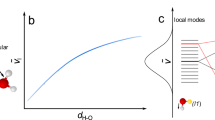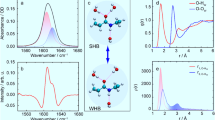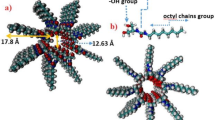Abstract
IT is generally accepted that the main groups which attract water in the proteins keratin and silk are the amide (NHCO) groups. The partial molar heat of absorption (ΔH) of water at zero water content is −3 kcal/mole referred to liquid water, and this has been considered to represent the excess strength of two OH—O=C hydrogen bonds relative to two OH—O–H bonds in liquid water. Recent work1 has shown that although other polymers containing the amide group, such as polyvinyl acetamide and polyvinyl butyramide, give a similar result, corresponding simple liquid amides such as N-methyl acetamide and N-n-butyl acetamide give values of ΔH about −1 kcal/mole. This would appear to be a property common to many polar polymers and related “monomers”.
This is a preview of subscription content, access via your institution
Access options
Subscribe to this journal
Receive 51 print issues and online access
$199.00 per year
only $3.90 per issue
Buy this article
- Purchase on SpringerLink
- Instant access to full article PDF
Prices may be subject to local taxes which are calculated during checkout
Similar content being viewed by others
References
Ramsden, D. K., thesis, Univ. Leeds (1965).
Barrer, R. M., Barrie, J. A., and Slater, J., J. Polymer Sci., 27, 177 (1958).
Dinkard, W., and Kivelson, D., J. Phys. Chem., 62, 1494 (1958).
Author information
Authors and Affiliations
Rights and permissions
About this article
Cite this article
WOOD, F., RAMSDEN, D. & KING, G. Hydrogen Bonding of Water in Substances containing the Amide Group. Nature 212, 606 (1966). https://doi.org/10.1038/212606a0
Published:
Issue date:
DOI: https://doi.org/10.1038/212606a0



